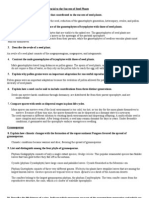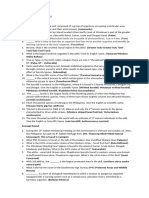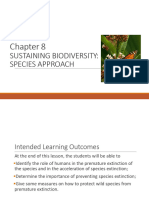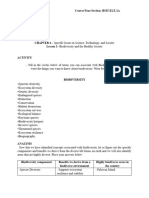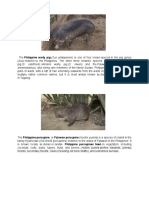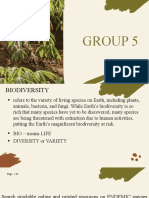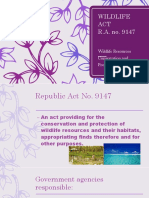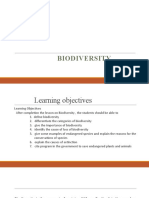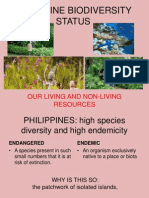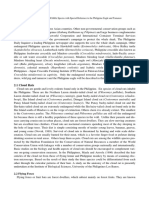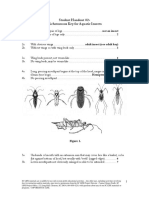0 ratings0% found this document useful (0 votes)
37 viewsSTS IUCN Red List
STS IUCN Red List
Uploaded by
Lexter CrudaThe document lists 10 organisms from the Philippines that are included on the IUCN Red List as endangered or critically endangered, including the Philippine Eagle, Tamaraw, and Philippine Crocodile. Habitat loss due to deforestation for agriculture and development is cited as a major threat for many of the species. The list includes both plant and animal species endemic to regions of the Philippines.
Copyright:
© All Rights Reserved
Available Formats
Download as PDF, TXT or read online from Scribd
STS IUCN Red List
STS IUCN Red List
Uploaded by
Lexter Cruda0 ratings0% found this document useful (0 votes)
37 views2 pagesThe document lists 10 organisms from the Philippines that are included on the IUCN Red List as endangered or critically endangered, including the Philippine Eagle, Tamaraw, and Philippine Crocodile. Habitat loss due to deforestation for agriculture and development is cited as a major threat for many of the species. The list includes both plant and animal species endemic to regions of the Philippines.
Copyright
© © All Rights Reserved
Available Formats
PDF, TXT or read online from Scribd
Share this document
Did you find this document useful?
Is this content inappropriate?
The document lists 10 organisms from the Philippines that are included on the IUCN Red List as endangered or critically endangered, including the Philippine Eagle, Tamaraw, and Philippine Crocodile. Habitat loss due to deforestation for agriculture and development is cited as a major threat for many of the species. The list includes both plant and animal species endemic to regions of the Philippines.
Copyright:
© All Rights Reserved
Available Formats
Download as PDF, TXT or read online from Scribd
Download as pdf or txt
0 ratings0% found this document useful (0 votes)
37 views2 pagesSTS IUCN Red List
STS IUCN Red List
Uploaded by
Lexter CrudaThe document lists 10 organisms from the Philippines that are included on the IUCN Red List as endangered or critically endangered, including the Philippine Eagle, Tamaraw, and Philippine Crocodile. Habitat loss due to deforestation for agriculture and development is cited as a major threat for many of the species. The list includes both plant and animal species endemic to regions of the Philippines.
Copyright:
© All Rights Reserved
Available Formats
Download as PDF, TXT or read online from Scribd
Download as pdf or txt
You are on page 1of 2
Republic of the Philippines
Laguna State Polytechnic University
Province of Laguna
Name: Kimberly S. Hernandez Subject: STS
Course & Section: BEED II-A Instructor: Mrs. Gaynor Tenerife
Organisms found in the Philippines that is included in the IUCN redlist. Give
atleast 10 organisms (Flora or Fauna).
1. Philippine Eagle (Pithecophaga jefferyi)
- also known as the monkey-eating eagle, is listed as Critically Endangered on
the IUCN Red List. This majestic bird is one of the largest and most powerful
eagles in the world, but it's also one of the most threatened. The primary
reason for its endangered status is the loss of its natural habitat due to
deforestation
2. Tamaraw (Bubalus mindorensis)
- also known as the Mindoro dwarf buffalo, is included in the IUCN Red List as
Critically Endangered because of habitat loss and hunting.
3. Philippine Crocodile (Crocodylus mindorensis)
- also known as the Mindoro crocodile or the Philippine freshwater crocodile, is
included in the IUCN Red List as Critically Endangered because of their habitat
loss and degredation. This species is found in freshwater habitats such as
rivers, lakes, and marshes.
4. Visayan Warty Pig (Sus cebifrons)
- endemic to six of the Visayan Islands in the central Philippines. Its natural
habitat, which includes forests and grasslands, has been significantly reduced
due to deforestation and conversion of land for agriculture and human
settlements. This loss of habitat has greatly impacted the population of the
species.
5. Palawan Peacock-Pheasant (Polyplectron napoleonis)
- endemic to the island of Palawan in the Philippines. Ongoing habitat loss,
primarily due to deforestation and conversion of land for agriculture and
human settlements, has significantly reduced its available habitat. This loss of
habitat has had a negative impact on the population of the species.
6. Rafflesia Schadenbergiana: This is one of the largest flowers in the world and is
found in Mindanao
7. Paphiopedilum Ciliolare: This is a species of orchid that is native to the
Philippines. It's considered endangered due to habitat loss and over-collection
8. Medinilla Magnifica: Also known as the showy medinilla or rose grape, this plant
is native to the Philippines.
9. Nepenthes Attenboroughii: This pitcher plant, named after Sir David
Attenborough, is native to Palawan.
10. Shorea Astylosa: This is a species of plant in the family Dipterocarpaceae, and
it's endemic to the Philippines. It's considered critically endangered due to
deforestation.
You might also like
- BUMHS MDCAT Past PapersDocument26 pagesBUMHS MDCAT Past Papersfirasahmed171No ratings yet
- Identifying The Interacting Partners of Bub1bDocument5 pagesIdentifying The Interacting Partners of Bub1bTim Hepburn100% (1)
- BIO CH24 L04 QuizDocument3 pagesBIO CH24 L04 QuizShamma Ahmed AlshamsiNo ratings yet
- AP Biology - Chapter 30 Discussion AnswersDocument3 pagesAP Biology - Chapter 30 Discussion Answersangel91me6371100% (6)
- Endemic and Endangered Plants and AnimalDocument4 pagesEndemic and Endangered Plants and AnimalIssa 23No ratings yet
- Origin of The AlbaniansDocument13 pagesOrigin of The AlbaniansLinas Kondratas100% (2)
- Endangered Species TranscriptDocument5 pagesEndangered Species TranscriptJerric CristobalNo ratings yet
- Threatened and Endemic Wildlife of The PhilippinesDocument4 pagesThreatened and Endemic Wildlife of The PhilippinesGea May BrillantesNo ratings yet
- Saving The Philippine Eagle As A Way of Saving The Nation'S FreedomDocument5 pagesSaving The Philippine Eagle As A Way of Saving The Nation'S FreedomJinky FernandezNo ratings yet
- Cardeno - Assessmen 2Document14 pagesCardeno - Assessmen 2reygie cardenoNo ratings yet
- Ecoregions in The PhilippinesDocument4 pagesEcoregions in The PhilippinesMira Lei MarigmenNo ratings yet
- 50 Critically Endangered Species in The PhilippinesDocument12 pages50 Critically Endangered Species in The Philippinesdelacruzylanna01No ratings yet
- Endemic Species Found in The Albay Biosphere ReserveDocument13 pagesEndemic Species Found in The Albay Biosphere ReserveClark100% (1)
- Status of the Philippine Biodiversity................Document63 pagesStatus of the Philippine Biodiversity................reychielmaetaypinNo ratings yet
- Yz ThineDocument19 pagesYz ThineMhel ChieeNo ratings yet
- Philippine Wildlife Species Profile ActivityDocument2 pagesPhilippine Wildlife Species Profile ActivitySUMMER CONSTANTINONo ratings yet
- Wildlife National Quiz Bee Questions 2015Document2 pagesWildlife National Quiz Bee Questions 2015Vohn Archie EdjanNo ratings yet
- Red-Vented CockatooDocument15 pagesRed-Vented CockatooJay-Jay PeregrinNo ratings yet
- Chap 8Document55 pagesChap 8autistickidd1No ratings yet
- Synthesis Paper in Biology III: Extinction of Philippine EaglesDocument9 pagesSynthesis Paper in Biology III: Extinction of Philippine EaglesPreciousAnneAnchetaMabazza0% (2)
- AmpibiansDocument3 pagesAmpibiansRhea Jean BeresoNo ratings yet
- Biodiversity PDFDocument78 pagesBiodiversity PDFRaymond LuberiaNo ratings yet
- Endangered Plants and Animals in The Philippines: Jay Paul O Tuyay PresenterDocument14 pagesEndangered Plants and Animals in The Philippines: Jay Paul O Tuyay PresenterJulski TuyayNo ratings yet
- Script Bio VlogDocument2 pagesScript Bio Vlogfrenzrovinnunez10No ratings yet
- Chapter 4 Lesson 2Document7 pagesChapter 4 Lesson 2BjayNo ratings yet
- 10 Endangered Philippine AnimalsDocument28 pages10 Endangered Philippine AnimalsMyleenx PrlntlngshopNo ratings yet
- Endangered Animals1Document11 pagesEndangered Animals1Gloria TumacasNo ratings yet
- Myka ScienceDocument14 pagesMyka ScienceMJ AndrabadoNo ratings yet
- Terminal Activity 3 (Second Quarter) - PEREZDocument6 pagesTerminal Activity 3 (Second Quarter) - PEREZNah Lobo PerezNo ratings yet
- STS IucnDocument3 pagesSTS IucncyriljaymoralescanjaNo ratings yet
- (DU) Species in The Philippines - Science 4Q Asynchronous ActivityDocument3 pages(DU) Species in The Philippines - Science 4Q Asynchronous ActivityaliyahsduNo ratings yet
- Assignment Scinece Miggy December 7 2020Document5 pagesAssignment Scinece Miggy December 7 2020Juztine Aquino AmbrosioNo ratings yet
- M9 Learning ActivityDocument5 pagesM9 Learning ActivityMaria Louella MagadaNo ratings yet
- STS BiodiversityDocument5 pagesSTS BiodiversityAndrea OesmerNo ratings yet
- 9 Endangered Species in The PhilippinesDocument9 pages9 Endangered Species in The PhilippinesGoDonJ TVNo ratings yet
- Learning Activity - Biodiversity and Health SocietyDocument5 pagesLearning Activity - Biodiversity and Health SocietyManoj MudirajNo ratings yet
- Term Paper Phil EagleDocument18 pagesTerm Paper Phil Eaglejoy herbasNo ratings yet
- Endagered Species in The PhilippinesDocument3 pagesEndagered Species in The PhilippinesBusilaoco, Frances Eve M.No ratings yet
- Republic Acts and Ecological Animals ReviewerDocument3 pagesRepublic Acts and Ecological Animals ReviewerMa Juwan Xyza MalazaNo ratings yet
- Threats To Endemic Squirrels in Philippines Biology JournalDocument3 pagesThreats To Endemic Squirrels in Philippines Biology JournaljulianaNo ratings yet
- DraftDocument8 pagesDraftDence De LaraNo ratings yet
- Flagship SpeciesDocument23 pagesFlagship Speciesgregoriodale2No ratings yet
- Science Philippines Species Endangered BirdsDocument5 pagesScience Philippines Species Endangered BirdsSid LimNo ratings yet
- Flora and FaunaDocument17 pagesFlora and FaunaKrisha Apale DingdingNo ratings yet
- Gempero Levie EcologyDocument22 pagesGempero Levie EcologyHeizyl ann VelascoNo ratings yet
- Philippine FalconetDocument8 pagesPhilippine FalconetMar Sayos DalesNo ratings yet
- Group 5Document8 pagesGroup 5John Rey MontemorNo ratings yet
- 10 Endangered Species That Is Located in The Philippine ArchipelagoDocument29 pages10 Endangered Species That Is Located in The Philippine ArchipelagoMystic BoyNo ratings yet
- Philippine Eagle: A. Ways On How We Can Help in Saving The Critically Endangered Animals in The Philippines. (30 Points)Document4 pagesPhilippine Eagle: A. Ways On How We Can Help in Saving The Critically Endangered Animals in The Philippines. (30 Points)Fiona SuzenneNo ratings yet
- Endemic Plants and Animals in The Philippines: 1. Tamaraw 4. PilandokDocument4 pagesEndemic Plants and Animals in The Philippines: 1. Tamaraw 4. PilandokRhoda Domaoal QuitanNo ratings yet
- Biodiversity WILDLIFE ACTDocument32 pagesBiodiversity WILDLIFE ACTEmil EnriquezNo ratings yet
- Mammal Erinaceidae Endemic Philippines Habitat ForestsDocument1 pageMammal Erinaceidae Endemic Philippines Habitat ForestsCzarina HernandezNo ratings yet
- The Philippine MenagerieDocument33 pagesThe Philippine MenagerieJC MagsinoNo ratings yet
- WALADocument5 pagesWALAJohn Marines EstiocoNo ratings yet
- BiodivesrityDocument27 pagesBiodivesrityJemimah Anne Santos FerrerNo ratings yet
- PPTDocument40 pagesPPTMhaithan Hernandez CaliuagNo ratings yet
- Philippine BiodiversityDocument40 pagesPhilippine BiodiversityJoy Eva100% (2)
- BIOL 181 - Corridor ADocument20 pagesBIOL 181 - Corridor AParagoso FhemNo ratings yet
- Flora Fauna Biodiversity Conservation of The PhilippinesDocument4 pagesFlora Fauna Biodiversity Conservation of The PhilippinesBhea Lyn SomblingoNo ratings yet
- Philippines - Plant and Animal LifeDocument8 pagesPhilippines - Plant and Animal LifeRQL83appNo ratings yet
- JIDC 08 01 01 Maala-1-17-3Document1 pageJIDC 08 01 01 Maala-1-17-3Jane Carol MallariNo ratings yet
- Bighorn Sheep: Contributions of Montana State University Graduate Students to Understanding a Vulnerable Species, 1965-2000From EverandBighorn Sheep: Contributions of Montana State University Graduate Students to Understanding a Vulnerable Species, 1965-2000Rating: 1 out of 5 stars1/5 (1)
- Kaya 2015Document6 pagesKaya 2015Rosi Nurbaeti PutriNo ratings yet
- NullDocument23 pagesNullsar0000No ratings yet
- Thesis Statement For Informative Speech On Breast CancerDocument6 pagesThesis Statement For Informative Speech On Breast Cancerlucienicolasstockton100% (1)
- Incidence and Distribution of Citrus Tristeza Virus in Citrus Cultivars in Ibadan, Southwest NigeriaDocument4 pagesIncidence and Distribution of Citrus Tristeza Virus in Citrus Cultivars in Ibadan, Southwest NigeriaShailendra RajanNo ratings yet
- Pinggang PinoyDocument12 pagesPinggang PinoyReynold O. Braza100% (4)
- Date Sheet Dec 2015 PDFDocument126 pagesDate Sheet Dec 2015 PDFamandeep651No ratings yet
- Practice For Test Week 2 SL AnswersDocument18 pagesPractice For Test Week 2 SL AnswersalasdairpetietNo ratings yet
- tr596 508Document260 pagestr596 508api-348272721100% (1)
- Multispe QDocument17 pagesMultispe QChathuranga De SilvaNo ratings yet
- Suture Materials and Suture TechniquesDocument17 pagesSuture Materials and Suture TechniquesimranNo ratings yet
- Proposal s3Document11 pagesProposal s3RifqiNo ratings yet
- Androgenesis, Gynogenesis and The Production of Clones in Fishes: A ReviewDocument24 pagesAndrogenesis, Gynogenesis and The Production of Clones in Fishes: A ReviewssotomNo ratings yet
- DLL 2Document2 pagesDLL 2marizel salcedoNo ratings yet
- Item:: E L E EDocument7 pagesItem:: E L E Eshahbaz HazardousNo ratings yet
- Student Handout #2-Dichotomous Key For Aquatic InsectsDocument7 pagesStudent Handout #2-Dichotomous Key For Aquatic InsectsAndres Germán FuentesNo ratings yet
- Assignment 2 Lesson Plan (Due Oct 10)Document3 pagesAssignment 2 Lesson Plan (Due Oct 10)api-278713448No ratings yet
- Clinical Microbiology NotesDocument10 pagesClinical Microbiology NotesCaraDeleNo ratings yet
- LAS-Gen - Bio2 MELC 5 Q3-Week-3 PDFDocument9 pagesLAS-Gen - Bio2 MELC 5 Q3-Week-3 PDFJayma RomeNo ratings yet
- Fmicb 10 00053Document23 pagesFmicb 10 00053hafniomonNo ratings yet
- 2nd Grading Grade 4 Regular ScienceDocument4 pages2nd Grading Grade 4 Regular ScienceOnimeg Nigyl100% (1)
- Lesson 3 Marketing - PerceptionDocument22 pagesLesson 3 Marketing - Perceptionapi-639942719No ratings yet
- Calcium Channel BlockersDocument34 pagesCalcium Channel BlockersZulva Fuadah ANo ratings yet
- Classifying Compounds As Prebiotics - Scientific Perspectives and RecommendationDocument17 pagesClassifying Compounds As Prebiotics - Scientific Perspectives and RecommendationElson TavaresNo ratings yet
- Combination of Topical and Oral Glutathione As A Skin-Whitening Agent: A Double-Blind Randomized Controlled Clinical TrialDocument6 pagesCombination of Topical and Oral Glutathione As A Skin-Whitening Agent: A Double-Blind Randomized Controlled Clinical TrialLwsynergylab OfficialNo ratings yet
- En Abbott Realtime Hiv-1: Customer Service International: Call Your Abbott RepresentativeDocument24 pagesEn Abbott Realtime Hiv-1: Customer Service International: Call Your Abbott RepresentativegdurouxNo ratings yet



